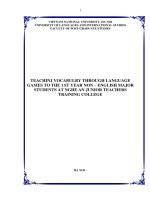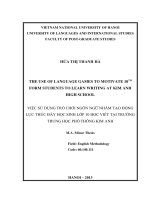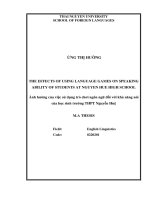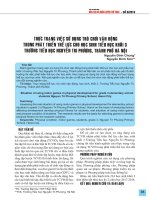Ảnh hưởng của việc sử dụng trò chơi ngôn ngữ đối với khả năng nói của học sinh trường THPT nguyễn huệ
Bạn đang xem bản rút gọn của tài liệu. Xem và tải ngay bản đầy đủ của tài liệu tại đây (517.39 KB, 87 trang )
THAI NGUYEN UNIVERSITY
SCHOOL OF FOREIGN LANGUAGES
ỨNG THI HƯỜNG
THE EFFECTS OF USING LANGUAGE GAMES ON SPEAKING
ABILITY OF STUDENTS AT NGUYEN HUE HIGH SCHOOL
Ảnh hưởng của việc sử dụng tro chơi ngôn ngữ đối với khả năng nói
của học sinh trường THPT Nguyễn Huê
M.A THESIS
Field:
English Linguistics
Code:
8220201
THAI NGUYEN – 2018
THAI NGUYEN UNIVERSITY
SCHOOL OF FOREIGN LANGUAGES
ỨNG THI HƯỜNG
THE EFFECTS OF USING LANGUAGE GAMES ON SPEAKING
ABILITY OF STUDENTS AT NGUYEN HUE HIGH SCHOOL
Ảnh hưởng của việc sử dụng tro chơi ngôn ngữ đối với khả năng nói
của học sinh trường THPT Nguyễn Huê
M.A THESIS
(APPLICATION ORIENTATION)
Field:
English Linguistics
Code:
8220201
Supervisor:
Dr. Dương Đức Minh
THAI NGUYEN – 2018
STATEMENT OF AUTHORSHIP
This is to certify that the thesis entitled “The Effects of Using Language
Games on Speaking Ability of Students at Nguyen Hue High School” has been
written by me and the work in it has not previously been submitted for a degree. In
addition, I also certify that all information sources and literature have been indicated
in the thesis.
Thai Nguyen, October 2018
Ứng Thi Hường
i
ACKNOWLEDGEMENTS
During the process of carrying out this study, I have received a large amount
of contribution and support from many people.
First, I would like to express the deepest gratitude to my supervisor, Dr. Dương
Đức Minh, for his invaluable encouragement and useful advice during the whole
process of this master thesis. Without his help, this paper could not have been
completed.
Next, I am thankful to all my lecturers as well as staff at School of Foreign
Languages, Thai Nguyen University for their great supports and suggestions.
Also, I am grateful to the teachers of English and the students at Nguyen Hue
high school for their immense help and participation.
Finally, my special thanks go to my beloved family and friends for their love,
care and support during my MA course, especially on the completion of this thesis.
Thai Nguyen, October 2018
Ứng Thi Hường
ii
ABSTRACT
It goes without saying that speaking plays an important role in learning a
foreign language. However, in the context of learning English in Vietnamese high
schools, students’ speaking is generally far from satisfactory. This study, hence,
aims at investigating the effects of using language games on students’ speaking
ability. The study was guided by two research questions regarding the extent to
which the use of language games impacts students’ speaking skill and how students
evaluate this technique. To answer those questions, an action research in twelve
weeks was carried out. The participants included 40 grade 11th students at Nguyen
Hue high school. The data were collected from observation sheets and
questionnaires, and subsequently were visualized and discussed. The data from
observation sheets indicates that though the use of language games did not result in
change in the students’ ability to use the target language to speak, these activities
helped the class atmosphere to be more enjoyable and the students more motivated.
Furthermore, it is demonstrated from the questionnaires that the students held a
positive attitude towards the use of language games in their speaking lessons.
3
TABLE OF CONTENTS
STATEMENT
OF
AUTHORSHIP.........................................................................................i
ACKNOWLEDGEMENTS ................................................................................................ii
ABSTRACT.........................................................................................................................iii
LIST OF TABLES ............................................................................................................... v
LIST OF FIGURES AND CHARTS................................................................................vii
Chapter I: INTRODUCTION ............................................................................................ 1
1.1. Rationale ..................................................................................................................... 1
1.2. Aims of the study ........................................................................................................ 2
1.3. Scope of the study....................................................................................................... 2
1.4. Significance of the study............................................................................................. 2
1.5. Outline of the thesis .................................................................................................... 2
Chapter II: LITERATURE REVIEW............................................................................... 4
2.1. Speaking teaching ....................................................................................................... 4
2.1.1. Definitions of speaking skill................................................................................. 4
2.1.2. The teaching of speaking ..................................................................................... 4
2.1.3. Speaking activities ............................................................................................... 8
2.1.4. The teaching of English speaking in Vietnam...................................................... 6
2.2. Language games ....................................................................................................... 11
2.2.1. Definitions of language games .......................................................................... 11
2.2.2. Reasons for using language games.................................................................... 12
2.2.3. Types of language games ................................................................................... 13
2.2.4. Principles of using language games .................................................................. 15
2.4. Previous studies ........................................................................................................ 16
2.5. Concluding remarks .................................................................................................. 18
Chapter III: RESEARCH METHODOLOGY ...............................................................
19
3.1. Research questions.................................................................................................... 19
3.2. Research participants ................................................................................................ 19
3.3. Research design ........................................................................................................ 20
3.4. Data collection instruments ...................................................................................... 23
3.4.1. Observation........................................................................................................ 23
3.4.2. Questionnaires ................................................................................................... 24
3.5. Procedure of data collection ..................................................................................... 24
Chapter IV: FINDINGS AND DISCUSSIONS............................................................... 26
4.1. The effect of language games on students’ speaking ability .................................... 26
4.2. The students’ attitudes towards the use of language games ..................................... 33
4
4.2.1. Findings from the questionnaires....................................................................... 33
4.2.2. Findings from the Observation Sheets No.2 ...................................................... 41
5
4.3. Discussion ................................................................................................................. 41
4.4. Concluding remarks .................................................................................................. 42
Chapter V: CONCLUSIONS AND RECOMMENDATIONS ...................................... 44
5.1. Summary ................................................................................................................... 44
5.2. Recommendations..................................................................................................... 45
5.3. Limitations of the study ............................................................................................ 46
5.4. Suggestions for further study .................................................................................... 46
REFERENCES................................................................................................................... 47
APPENDICES .......................................................................................................................I
6
LIST OF TABLES
Table 1: Comparison between the results of the 1st observation and those of the 2nd
observation ................................................................................................................33
Table 2: Students’ opinion about their speaking skill ...............................................35
Table 3: Students’ preferences of class grouping in language games ......................40
7
LIST OF FIGURES AND CHARTS
Chart 1: The students’ individual participation in the first observation ...................28
Chart 2: The students’ individual participation in the second observation...............32
Chart 3: The students’ opinion about learning speaking...........................................34
C h a r t 4 : T h e s t u de n ts ' o p i ni o n a b o u t t he e f f e c t of la n g u a ge
ga me s o n th e i r s p e a k i ng
s k i ll
......................................................................................................35
Chart 5: The students’ opinions about the benefits of language games....................36
Chart 6: The students’ attitudes towards the teacher’s instructions to the games ....38
Chart 7: The students’ difficulties when taking part in language games ..................39
vii
Chapter I: INTRODUCTION
1.1. Rationale
Speaking skill is an important part of learning English. Those who learn
English always wish to use this skill as well as they can. Speaking English fluently
is the key that enables people to communicate with foreigners easily, accept the
advance of technology and get success in their jobs. Especially, in the era of
globalization, English oral proficiency has become much more necessary than ever
as it is used in every domain of the world. In Vietnam, English is one of compulsory
subjects from primary to tertiary education and speaking English has been taught for
years with the hope to help students communicate by this language successfully.
However, it is a fact that while many students study English grammar very
well, they cannot master it just because they get difficulties in their speaking. This
problem is really clear at Nguyen Hue high school where students have to face a
number of obstacles. First, geographical and economic conditions have led to
limited educational environment. Some students even do not have sufficient
time and materials to learn. In addition, the traditional approach and examination
format focusing on grammar and vocabulary appear to demotivate students. Most
of the English lesson time is spent on teaching and learning structures and new
worlds, students do not have much opportunity to practice speaking and eventually
lose their interest in learning speaking.
After two years working with mountainous students in English lessons, the
researcher found that more than a half of them have problem with the speaking skill.
They feel difficult to express their ideas and it often takes them long time to make
sentences or speak out the ideas despite the fact that they know the words and
structures. Moreover, their ability of language production is limited, they are not
productive and creative enough in English speaking skill. In many students’ opinion,
learning by heart dialogues and practicing repetition of drills are enough in speaking
classes. Though some techniques have been applied to raise their interests and
improve their oral skill, the results seem not to be acceptable. Students still find
speaking challenging and they are not confident enough to communicate in English.
Those reasons have driven the researcher to carry out the present study to
apply
1
and evaluate the impacts of language games on speaking classes. With the title “The
Effects of Using Language Games on Speaking Ability of Students at Nguyen
Hue High School”, the paper is expected to be beneficial to teachers, students and
those who want to improve learners’ speaking skill.
1.2. Aims of the study
The principal purpose of the study is to help Vietnamese leaners improve
their English speaking skill, particularly those in mountainous areas by
implementing language games in speaking classes. In details, the study intends to
investigate the effects of using language games on students’ speaking and to gain
understanding of the students’ opinion and attitudes towards this technique.
Therefore, the research aims at answering two questions:
1. To what extent do language games affect the students’ English speaking
ability?
2. What are the students’ attitudes towards language games in their
English speaking classes?
1.3. Scope of the study
The research focuses on studying how using language games affects speaking
ability of 11th grade students at Nguyen Hue high school and how they evaluate
language games in their classes.
1.4. Significance of the study
The current study is believed to make important contributions in some ways.
First of all, the research results would help teachers and educators of English to
recognize how language games affect their speaking classes and then adjust their
teaching so as to meet the students’ needs. It can also provide teachers with possible
suggestions to improve the use of games in their classrooms. Second, through the
games in the classes, it is hoped that students will be more interested in learning
speaking and become more confident when communicating in English.
1.5. Outline of the thesis
As required, the paper will have such main parts as follows:
Chapter I: INTRODUCTION, presents statement of the problem and
rationale for the study, aims, scope, significance, and outline of the study.
Chapter II: LITERATURE REVIEW, clarifies theoretical background and
related studies relevant for the research.
Chapter III: RESEARCH METHODOLOGY, elicits information related
to research questions, research methods, data collection, data procedure, coding
scheme, and data analysis.
Chapter IV: FINDINGS AND DISCUSSION is the main part of the study
and will be divided into two subsections, correspondent to two research questions.
First, the extent to which language games influence students’ speaking ability is
reported. Subsequently, students’ attitudes towards the use of this strategy are
displayed.
Chapter V: CONCLUSION, summarizes essential findings, provides some
linguistic and pedagogical implications, and gives suggestions for further studies.
Besides, there should be REFERENCES and APPENDICES if any at the
end of the research.
Chapter II: LITERATURE REVIEW
This chapter is to present an overview of the theoretical background, which
consists of three main parts. The first part deals with the teaching speaking in
general and the teaching of this skill in Vietnamese education context in particular.
The second one discusses language games and their application in speaking classes.
Finally, related previous studies are considered to figure out how language games
have been utilized to teach speaking.
2.1. Speaking teaching
2.1.1. Definitions of speaking skill
As a part of daily life that people acquire since they are children, speaking
plays a significant role in communicating, thinking and learning in a language.
Therefore, various linguists and educators have attempted to define it. According to
Chaney (1998, p. 13), speaking is defined as “the process of constructing and
sharing meaning via the use of verbal and non – verbal symbols, in a variety of
context.” Cameron (2001) considers speaking as the active use of language to
convey meanings for other people to understand them. She adds that speaking is
more difficult than listening because it involves not only comprehension but also
production. Also, Hybel (2001) states that speaking is any process in which people
share information, ideas and feeling, and meaning of a message communicated via
speaking is added by body language, mannerism and style.
Speaking is described as a social, multi – sensory speech event, whose topic
is unpredictable (Thornbury & Slade, 2006). The social feature of speaking is
typical since it establishes relationships and mutual agreement, strengthens and
changes social identity and relates interpersonal skills. It is indicated through
wishes, feelings, attitudes, opinions and judgments. Besides, speaking is considered
as a multi – sensory event because speakers employ various paralinguistic features
when they speak such as eye contact, facial expressions, body language, tempo,
pauses, voice quality changes and pitch variation. Furthermore, topics of speaking
are said to be unpredictable but native speakers tend to own regularly used phrases
during their talk.
2.1.2. The teaching of speaking
Mastering speaking skills is one of requisites when learning a second or
foreign language. Ur (2004) claims that “speaking seems intuitively the most
important: people who know a language are referred to as “speakers” of that
language … many if not most foreign language learners are primarily interested in
learning to speak” (p. 120). Besides, many consider improvement in oral
proficiency as the standard to evaluate the success of language learners or the
effectiveness of a language courses.
However, the concept of teaching and learning speaking has been addressed
differently in different periods. In the early 1970s, speaking was believed to be
“repeating after the teacher, reciting a memorized dialogue, or responding to a
mechanical drill” (Shrum and Glisan, 2000, p. 26). This approach concentrated on
proficiency at sentential level prevailing in Audiolingualism and Situational
Language Teaching. Since the 1980s, speaking has experienced significant shifts
due to the emergence of the constructs of communicative competence and
proficiency. The communicative competence theory has led to the development of
communicative syllabus, notional syllabuses and functional syllabus, as well as
proposals of task – based and text – based approaches. The focus of teaching
speaking then was on fluency that could be developed through various tasks
requiring learners to attempt real communication in spite of their limited proficiency
in English.
Today the bottom line in teaching this skill is how to help learners move
beyond the level of linguistic competence (mastery of the linguistic system), to
achieve communicative competence (understanding of how to use English
appropriately for a range of different communicative purposes, particularly social
purposes, educationally – related purposes and work – related purposes) (Richard,
2008). In his paper in 2013, Richard also summarizes principles reflected by current
approaches to the teaching of speaking as follow: (1) Speaking and oral interaction
is seen as the basis for learning; (2) Non – native usage as well as native usage both
serve as models; (3) English for cross – cultural communication is a primary goal;
(4) Models in classroom materials are often informed by corpus analysis; (5)
Functional or other types of communicative syllabus predominate; (6) Both accuracy
and fluency are a primary goal with a greater tolerance of errors; (7) Oral
proficiency is viewed
as dependent upon mastery of lexical phases and conversational routines; (8)
Cultural awareness is addressed; (9) Pair and group activities predominate in the
classroom (Richard, 2013).
Up to the present days, Kroeker (2009) summarizes three principal
approaches in the teaching of speaking a second or foreign language, namely
the indirect approach, the direct approach and indirect approach plus. In the indirect
approach, students develop their speaking skill when they actively take part in
interactive activities such as discussion, role-play, information gaps, and problemsolving activities. It is expected that if the interactions carried out are meaningful,
students speaking proficiency will improve. Meanwhile, the direct approach is
associated with information about a systematic program of micro skills,
communication strategy, language input, and processes that lead to fluent speaking.
The materials for direct approach are provided by speaking analysis, second
language acquisition and discourse analysis. When students are taught aspects of
speaking explicitly and have opportunities to practice, their speaking ability will
grow. This approach involves recording speaking to recognize student weaknesses
in reading real speaking transcripts, observing good speaker, and identifying the
differences between non- native and native speaking. Finally, the indirect plus
approach combines learner- centered training, language exposure, interactional
activities and teaching speaking as
a
spoken
discourse. This
approach
emphasizes specific language input and exposure to real speaking in a certain
order of activities.
2.1.3. The teaching of English speaking in Vietnam
The considerable growth and expansion of English in Vietnam has been
witnessed since 1986 and was marked by the overall economic reform known as
Đổi mới (Renovation). At present, English is a compulsory subject at both lower
and upper secondary levels and an elective subject at primary level where English
is introduced from Form 3 – 5. At higher education level, English is regarded both
as a discipline and as a subject. Besides, various English courses have been offered
by different centers outside the Formal Educational System. The rapid development
of English is easily seen and the quality of English teaching and learning cannot be
denied. However, the teaching and learning of English in Vietnam are confronting
many obstacles. In the scope of this study, some problems in teaching English
speaking are going to be highlighted.
One of the first problems is related to the teaching approach. Although
teaching English has been said to follow communicative trend with the focus on
practical communication skills, the presence of communicative approach is not
clearly seen in classrooms (Hoang, 2010). Teachers of English have had
opportunities to attend training programs with a focus on training communicative
teacher and are interested in the new method; yet they continue teaching in the
traditional ways. The current situations of English classes are that teachers and
students work mainly with reading comprehension, grammar and vocabulary
exercises. Speaking and listening are rarely taught though exercises for these two
skills are designed in the textbooks. The reason for this lies in the fact that the major
motivation for teaching and learning English is bound to examinations which do not
test their speaking skill.
Secondly, according to Hoang (2010), the teaching and testing are not in
parallel. While communicative approach has been adopted as mentioned above,
most of the exams, including end – of – school and university entrance exams –
focus on reading comprehension, vocabulary and structural patterns. Furthermore,
such international exams as TOEFL, TOEIC or IELTS, which are suitable for
measuring the knowledge and skills of English of those who intend to study in an
English – speaking country, are adopted to assess the students’ English capacity at
universities. This appears to make matters more complex (Hoang, 2010). Nguyen et
al (2015) adds that the paradox between the policy of applying communicative trend
and the absence of oral skills in exams results from financial and time concerns.
Clearly, the skills which are not covered in the testing systems will not draw
teachers’ and learners’ attention.
Another point to consider is associated with class time allocated for teaching
speaking. Many teachers claim that they do not have enough time to teach their
students speaking and communication although they wish to carry out these
activities. The time allocated for English in each semester was only enough for
teaching grammar, vocabulary, reading, writing, and listening. The teachers will run
out of time if they include speaking and communication activities (Nguyen et al,
2015).
Teachers’ speaking ability also raises much concern. Not all teachers of
English are able to speak this language fluently, particularly those who work at
lower levels of education. A lot of teachers have never spoken English to a native
speaker and they mainly use Vietnamese in their classes. It is clear that many
teachers cannot help their students practice English speaking effectively when they
are not competent speakers themselves.
With reference to the problems in speaking classes, Dao (2017) summarizes
ten major findings: (1) Teachers let students use much Vietnamese to express the
ideas; (2) Teachers do not emphasise English as the medium of instruction; (3)
Students’ background knowledge of English is low; (4) Students are shy and afraid
of making mistakes and speaking in public; (5) Students lack motivation to speak
English; (6) The curriculum and textbooks do not contain sufficient amount of
exercise for speaking skills; (7) Students are not given enough time for speaking
practice; (8) Teachers do not frequently organize communicative task to enhance
students’ speaking skills like role-plays, discussion, debates; (9) The environment in
speaking class is not really exciting and motivating; and (10) The large class size
impede the efficacy of students’ speaking performance.
Above are some of various problems that Vietnamese teachers and learners
have to face when it comes to English speaking. Obviously, more attention should
be paid to improve the quality of teaching and learning English speaking.
2.1.4. Speaking activities
According to Brown (2000), teaching speaking includes showing the details
of how to communicate and negotiate the ever elusive meaning of language. In
speaking classes, teachers should be aware of various speech activities as they are
quite distinct in form as well as function and require different teaching approaches.
Harmer (1993) distinguishes two kinds of speaking activities: practice
activities and communicative activities. Practice activities are further divided five
into groups: oral drills, information gap activities, games, personalization and
localization, and oral interactions. Meanwhile, communicative activities are
composed
of
reaching
a
consensus,
discussion,
replaying
instruction,
communication games, problem solving, talking about yourself, simulation and
role play.
In Ur’s taxonomy, there are three main types of oral activities (Ur, 2004). The
first one is brainstorming activities, including guessing games, finding connections,
ideas from a central theme, and implications and interpretations. The second kind is
organizing activities with comparing, detecting differences, putting in order,
priorities, choosing candidates, layout problems, and combining versions. The last
ones are compound activities like composing letters, debates, publicity campaigns,
surveys, and planning projects.
Brown (2000) suggests a model of classroom speaking performance with six
major types, including imitative, intensive, responsive, transactional, interpersonal
and extensive. In the first type, learners imitate “human tape recorder” speech, for
example to practice an intonation contour or to try to pinpoint a certain vowel sound.
Imitation accounts for a very limited portion of classroom speaking time and is
conducted not for the purpose of meaningful interaction but for focusing on certain
element of language form. The second type, intensive speaking, includes any
speaking performance that is designed to practice some phonological or grammatical
aspect of language. It can be self – initiated or form part of some pair work activity
where learners are going over certain forms of language. Next, responsive speaking
refers to sort replies to teacher or students – initiated questions or comments. These
replies are usually sufficient and do not extend into dialogues. Transactional
speaking performance goes one step beyond responsive language. It is carried out
for the purpose of conveying or exchanging specific information, which may have
more of a negotiable nature. Interpersonal speaking (or dialogue) is carried out
more for the purpose of maintaining social relationships than for the transmission
of facts and information. Finally, extensive performance (or monologue) may
include oral reports, summaries or perhaps short speeches. This kind of
speaking is often conducted by intermediate or advanced students.
Whatever the activity is, the successful speaking activities share certain
characteristics. Ur (2004) identifies four criteria for assessing the success of
students’ speaking. First, the more learners talk, the better the speaking result is.









